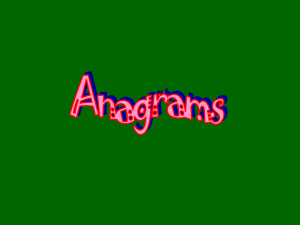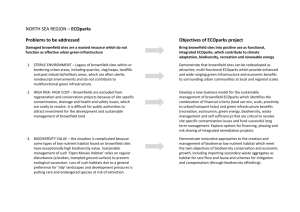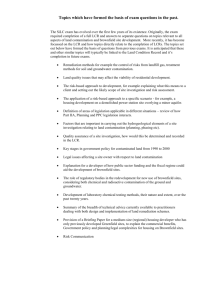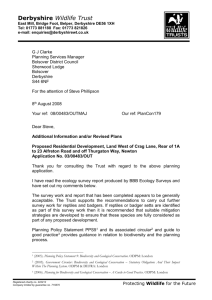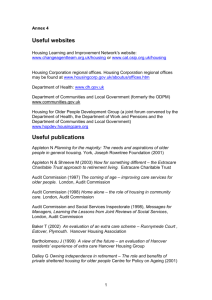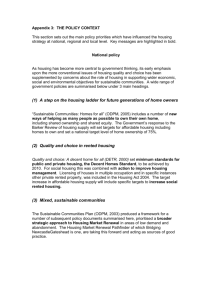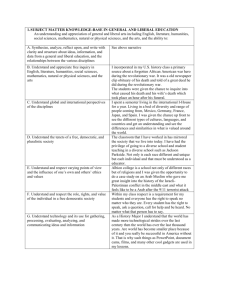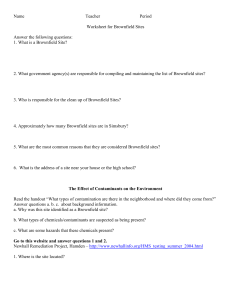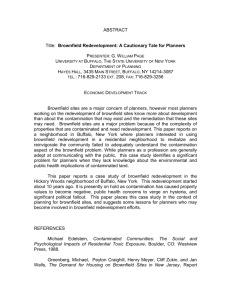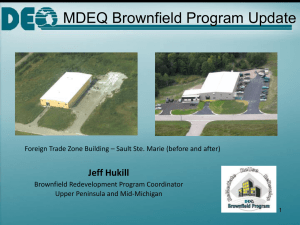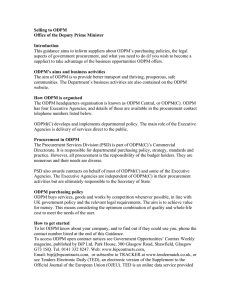Brownfield Development - Previously Developed Land (PDL)
advertisement
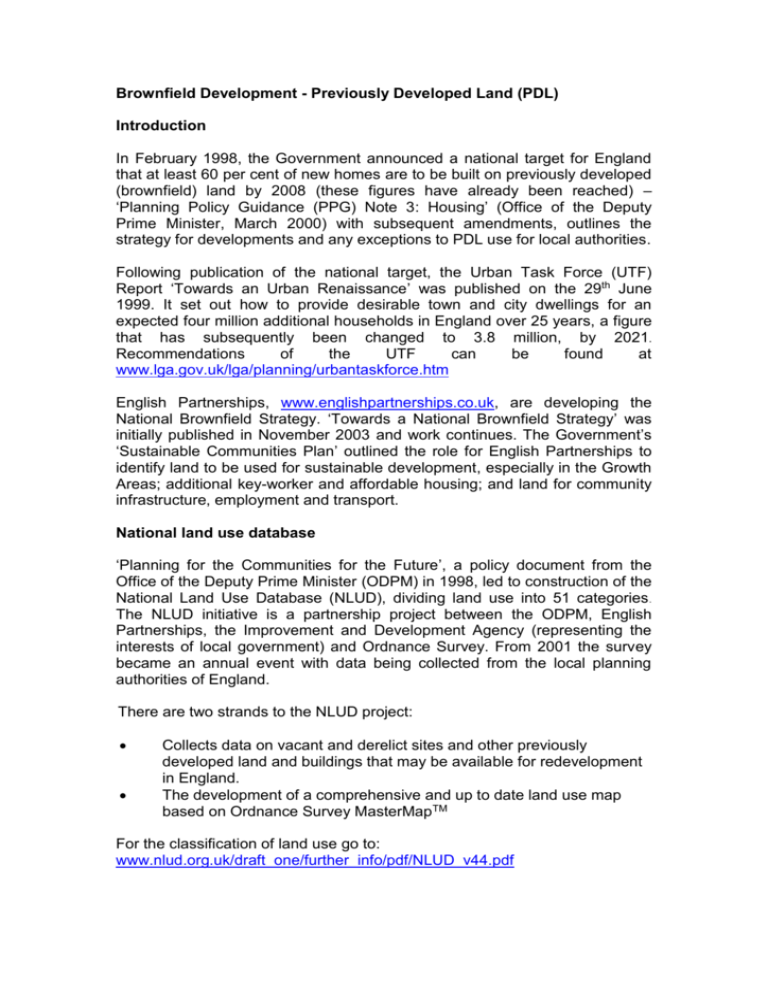
Brownfield Development - Previously Developed Land (PDL) Introduction In February 1998, the Government announced a national target for England that at least 60 per cent of new homes are to be built on previously developed (brownfield) land by 2008 (these figures have already been reached) – ‘Planning Policy Guidance (PPG) Note 3: Housing’ (Office of the Deputy Prime Minister, March 2000) with subsequent amendments, outlines the strategy for developments and any exceptions to PDL use for local authorities. Following publication of the national target, the Urban Task Force (UTF) Report ‘Towards an Urban Renaissance’ was published on the 29th June 1999. It set out how to provide desirable town and city dwellings for an expected four million additional households in England over 25 years, a figure that has subsequently been changed to 3.8 million, by 2021. Recommendations of the UTF can be found at www.lga.gov.uk/lga/planning/urbantaskforce.htm English Partnerships, www.englishpartnerships.co.uk, are developing the National Brownfield Strategy. ‘Towards a National Brownfield Strategy’ was initially published in November 2003 and work continues. The Government’s ‘Sustainable Communities Plan’ outlined the role for English Partnerships to identify land to be used for sustainable development, especially in the Growth Areas; additional key-worker and affordable housing; and land for community infrastructure, employment and transport. National land use database ‘Planning for the Communities for the Future’, a policy document from the Office of the Deputy Prime Minister (ODPM) in 1998, led to construction of the National Land Use Database (NLUD), dividing land use into 51 categories. The NLUD initiative is a partnership project between the ODPM, English Partnerships, the Improvement and Development Agency (representing the interests of local government) and Ordnance Survey. From 2001 the survey became an annual event with data being collected from the local planning authorities of England. There are two strands to the NLUD project: Collects data on vacant and derelict sites and other previously developed land and buildings that may be available for redevelopment in England. The development of a comprehensive and up to date land use map based on Ordnance Survey MasterMapTM For the classification of land use go to: www.nlud.org.uk/draft_one/further_info/pdf/NLUD_v44.pdf Previously Developed Land Brownfield land is commonly misinterpreted as meaning contaminated land; some is, but a better interpretation would be previously developed land (PDL). Urban regeneration of long term empty properties is seen as important for both meeting the 1998 national target whilst at the same time improving the aesthetics and condition of these areas for those who live and work around them. The UTF overall recommendation was the creation of sustainable city living to meet the demand for housing and minimise building on greenfield sites – with respect to other sustainability issues the recommendations include incorporating space for recreation, improving biodiversity and encouraging pedestrian rights of way and public transport use within the developments. In particular: Greening the residential environment is included in PPG 3; it is important to make areas desirable to live in but also to improve storm drainage and biodiversity, layout of buildings can improve energy efficiency. Areas for recreation are to be incorporated in new housing areas. ‘PPG17: Sport and Recreation’ gives further guidance on the provision of open space and playing fields. Urban degeneration Urban degeneration leads to derelict properties and previously developed land becoming available for brownfield development, linking in to the NLUD project and the Government’s Sustainable Communities Plan. There are many causes for Urban Degeneration including: low demand – usually attributed to area, poor quality, and least popular housing styles, such as smaller older terraces, or tenement flats; ignorance – owners simply don’t know how to get property back into use; policy – surplus property is sometimes kept due to uncertainty of future needs (e.g. schools); legislation – owners may not be able to afford to improve property due to building regulations or planning requirements; bad neighbours – including nearby pollution sources from industrial buildings, or heavy traffic, as much as ‘people’; and industrial/commercial re-location. Examples of re-development in areas of urban degeneration Even before the UTF report came out, The Peabody Trust www.peabody.org.uk was already making creative use of brownfield land. One of their principal activities in areas of London is redeveloping brownfield land, often derelict industrial sites, into housing, or into mixed schemes of homes and workspace. Examples of the work of The Peabody Trust include: BedZED 2002 www.bedzed.org.uk – Beddington Zero Energy Development. This is a carbon neutral community; energy is produced on site from renewable resources. The site was a former sewage works turned into 100 properties with green spaces and private gardens. Ladbroke Green www.peabody.org.uk/main/Pt4_3_2.asp in the UK Borough of Kensington and Chelsea – 308 dwellings and 17,000 sq m of commercial space integrated on a ten acre site, a re-modelled canal basin including preservation of a natural wetland area for biodiversity. Building for Life www.buildingforlife.org is an informative website including examples of projects both in the UK and abroad. It provides interesting examples of the commitment to sustainability and the environment. Sustainable living and work spaces have been developed in Bo 01: (The City of Tomorrow) Malmo, Sweden. This is a former car factory site, 30ha of 600 dwellings on a pedestrianised site – renewable energy resources, specific planting to increase biodiversity and take up of contamination from soils are evident in parks and open spaces, cycling and walking are encouraged. There are areas for shops, offices, restaurants and club facilities. Building for Life is a partnership between the House Builders Federation, CABE and the Civic Trust, all have information relating to sustainable regeneration. New Initiatives: Persimmon Homes is building five houses on a Brownfield site in Salford, these houses will be test sites for new products and building methods. To develop eco-home accreditation, Persimmon will be looking at energy conservation and geothermal energy supply, alternative heating systems, rainwater use, sourcing and construction of materials, manufacturing techniques. The Delivering Sustainable Communities Summit in Manchester (31 Jan to 2 Feb 2005) hosted by the Deputy Prime Minister, showcased this new initiative. For further information, the feedback report for the summit is available at: www.odpm.gov.uk/stellent/groups/odpm_communities/documents/divisionhom epage/029192.hcsp Results The government is already exceeding its target of 60 per cent of all new developments should be built on brownfield land. The rate of development on brownfield land in England increased from 56 per cent in 1997 to 67 per cent in 2003. Recently, proposals have been announced to strengthen protection of the green belt and stricter controls have been placed on housing density to cover more areas of high housing demand. The national statistics on house starts/completions are at: www.odpm.gov.uk/stellent/groups/odpm_housing/documents/page/odpm_hou se_604037.xls and by region at: www.odpm.gov.uk/stellent/groups/odpm_housing/documents/page/odpm_hou se_023723.xls
